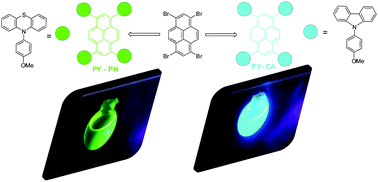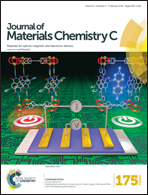Phenothiazine and carbazole substituted pyrene based electroluminescent organic semiconductors for OLED devices†
Abstract
Due to their easy availability, low cost and opportunities for exploiting reactions of bromo substituents, 1,3,6,8-tetrabromopyrene has attracted major attention in the organic electronics community for designing and constructing novel classes of pyrene based organic semiconducting functional materials. In the present work, 1,3,6,8-tetrabromo pyrene was transformed into the corresponding tetrasubstituted carbazole and phenothiazine derivatives using the classical Suzuki coupling reaction. These newly synthesized materials with a carbazole substituent (PY-CA) and a phenothiazine substituent (PY-PH) were characterised thoroughly and were successfully used as an active light-emitting layer in organic light emitting diodes which resulted in blue and green emission with promising device performance. PY-CA exhibited the maximum brightness at around 2500 cd m−2 and the power efficiency of 1.5 lm W−1 while that of PY-PH exhibited 2116 cd m−2 and 0.45 lm W−1 respectively.

- This article is part of the themed collection: 2016 Journal of Materials Chemistry C Most Accessed Manuscripts

 Please wait while we load your content...
Please wait while we load your content...